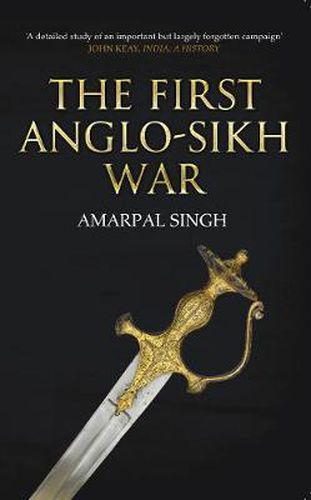Readings Newsletter
Become a Readings Member to make your shopping experience even easier.
Sign in or sign up for free!
You’re not far away from qualifying for FREE standard shipping within Australia
You’ve qualified for FREE standard shipping within Australia
The cart is loading…






During the eighteenth and early years of the nineteenth century, the red tide of British expansion had covered the entire Indian subcontinent reaching the borders of the Punjab. There the great Sikh ruler Runjeet Singh rapidly developed his army to thwart any British advance north of the Sutlej river into his Kingdom. The First Anglo-Sikh War broke out in 1845; from the start it was marred by Victorian arrogance and bluster on the British side, and personal ambition, intrigue and treason in the Sikh camp. Five keenly fought contests ensued, including the great battle of Ferozeshah. With its ammunition spent, artillery destroyed and with no food and water, the British force found itself caught between two powerful Sikh armies. The Governor-General Sir Hardinge accompanying the army gave orders to burn all state papers in preparation for the worst; the fate of India would be decided that day. Amarpal Sidhu writes a balanced tale using numerous eye witness accounts of the First Sikh War, a conflict characterised by treachery, suffering and incredible bravery on both sides. A wealth of photographs and new scale maps show the campaign as never before. This is an innovative approach to writing history. Each chapter of The First Anglo-Sikh War has a corresponding ‘Guide’ chapter giving first-hand accounts of visitors to the battlefield from just a few hours after the battle, when fresh corpses and the detritus of war cover the ground, to up to 30 years later, when the land has been reclaimed by forest and agriculture. The reader is then invited to take his own tour of the battlefield, either physically or virtually. GPS coordinates of particular assaults and troop and artillery formations have been meticulously collected by the author to provide an accurate map of events, which can be plotted against the modern landscape using accessible software such as Google Earth. Detailed walking guides of the battlefields are also given, tying together modern and historical landmarks.
$9.00 standard shipping within Australia
FREE standard shipping within Australia for orders over $100.00
Express & International shipping calculated at checkout
During the eighteenth and early years of the nineteenth century, the red tide of British expansion had covered the entire Indian subcontinent reaching the borders of the Punjab. There the great Sikh ruler Runjeet Singh rapidly developed his army to thwart any British advance north of the Sutlej river into his Kingdom. The First Anglo-Sikh War broke out in 1845; from the start it was marred by Victorian arrogance and bluster on the British side, and personal ambition, intrigue and treason in the Sikh camp. Five keenly fought contests ensued, including the great battle of Ferozeshah. With its ammunition spent, artillery destroyed and with no food and water, the British force found itself caught between two powerful Sikh armies. The Governor-General Sir Hardinge accompanying the army gave orders to burn all state papers in preparation for the worst; the fate of India would be decided that day. Amarpal Sidhu writes a balanced tale using numerous eye witness accounts of the First Sikh War, a conflict characterised by treachery, suffering and incredible bravery on both sides. A wealth of photographs and new scale maps show the campaign as never before. This is an innovative approach to writing history. Each chapter of The First Anglo-Sikh War has a corresponding ‘Guide’ chapter giving first-hand accounts of visitors to the battlefield from just a few hours after the battle, when fresh corpses and the detritus of war cover the ground, to up to 30 years later, when the land has been reclaimed by forest and agriculture. The reader is then invited to take his own tour of the battlefield, either physically or virtually. GPS coordinates of particular assaults and troop and artillery formations have been meticulously collected by the author to provide an accurate map of events, which can be plotted against the modern landscape using accessible software such as Google Earth. Detailed walking guides of the battlefields are also given, tying together modern and historical landmarks.